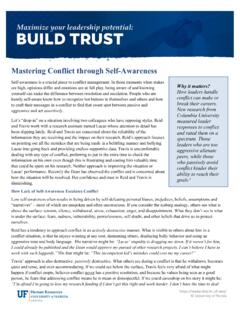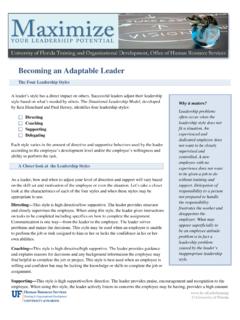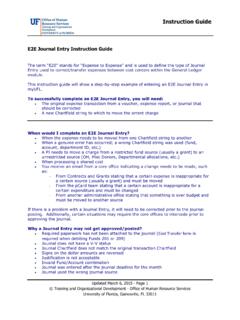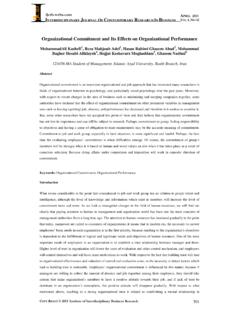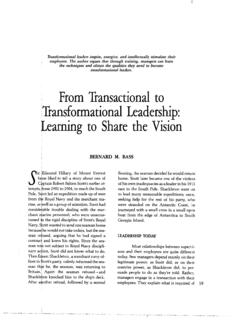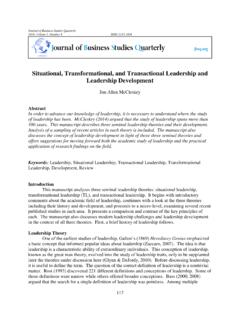Transcription of Six Effective Leadership Styles
1 University of Florida Six Effective Leadership Styles Podcast Transcript Hi my name is Tricia Bachus with UF's Training and Organizational Development department and today I would like to share six Effective Leadership Styles based on the emotional intelligence research done by author and psychologist Daniel Goleman. These six Styles are associated with positive emotional impacts that research shows have causal links to organizational results. His landmark Harvard Business Review study, published in 2000, determined that Leadership Styles were responsible for 30% of a company's bottom-line profitability. Those outstanding results are hard to When we work with UF leaders and ask this question, "What is your primary role or purpose as a leader," we often get a variety of responses.
2 While there is not one definitive answer, consider this idea: A leader has the capability of creating workplace resonance and greatly influencing employees to achieve organizational results. This idea of resonance is described in Goleman's book Primal Leadership2, as "the reservoir of positivity that frees the best in people. At its root, then, the primal job of Leadership is emotional ." This concept of emotion in the workplace is often misunderstood. Our first job as leaders is to deeply understand our own emotional landscape by becoming keen self-aware evaluators, expert managers of our feelings, empathic observers of other's emotions, and architects of trusting work relationships.
3 Once we are tapping into those four key areas, we can create workplace resonance by establishing the right conditions where people are literally on the same emotional wavelength as others, resulting in harmonious teamwork and amplifying the overall impact of our own Leadership . This idea of resonance, though, is not just how you, as the leader, show up in a particular mood or how skillfully you communicate the right things at the right moments, but it means being strategic about selecting Styles of Leadership based on presenting situations. Leadership Styles can promote or hamper resonance. Think of this ability as an artist with a blank canvas in front of her.
4 Her tools are paints, brushes and the vision she hopes to communicate churning inside her head. She selects her tools from a large array of different sized brushes to apply the paint in the texture or effect that brings her vision to life on the canvas, alternating between lighter or heavier brushstrokes. The right brush enables her to intentionally use her paint and her talent to create an image that resonates with viewers. So, too, does the choice of Leadership Styles enable leaders to influence the working environment that best aligns with their vision. So, let's review these strategic and Effective Leadership Styles . They are Visionary, Coaching, Affiliative, Democratic, Pacesetting, and Commanding.
5 Four of these approaches greatly foster the resonance needed for positive workplace performance, and two of them interfere with resonance when used ineffectively. However, all six should be part of your Leadership toolbox. The Visionary style is most suitable when a department or organization needs a new direction or employees need to connect to a shared dream. Goleman writes, "Visionary leaders articulate where a group is going, but not how it will get there -- setting people free to innovate, experiment, and take calculated risks. Knowing the big picture and how a given job fits in gives people clarity; they understand what's expected of them.
6 And the sense that everyone is working toward shared goals builds team commitments: People feel pride in belonging to their organization." This results in a strongly positive impact on climate. A leader who takes the time to hold deep conversations with employees about their lives, including dreams and goals, and often uses the phrase "Try this" is practicing the artful style of Coaching. This approach is often under-utilized by leaders University of Florida because of the perception that it takes valuable time to pursue. However, the opposite is often evident. When you invest the time in coaching, organizational efficiencies are frequently the end result.
7 The Coaching Leader directs and guides, deliberately fostering a positive workplace environment. It is most Effective when employees are more responsible, experienced, and enthusiastically engaged. The caution, however, is that it might be perceived as "micromanaging" to some employees. The key is knowing which employees are receptive to this style and which are not. The Affiliative leader can be summed up in one phrase, "People, or teams, come first." This style of Leadership is highly focused on creating trust and the emotional bonds that promote belonging to the organization or department. It works best in times of stress or when healing is needed from a crisis.
8 Goleman argues this approach is valuable "when trying to heighten team harmony, increase morale, improve communication or repair broken trust in an organization." An observer of this style would see a lot of group encouragement and praise that emphasizes the importance of harmony and teamwork. A note of caution, though, is to make sure poor performance does not go uncorrected. This could lead to the perception that the leader is allowing mediocrity to reign in order to have the much-desired harmony. When you hear a leader asking the question, "What do you think?" their focus is on building consensus through participation. This is the Democratic Leader who wants her team to have buy in or ownership of decisions, plans, and goals.
9 This style taps into collective wisdom using people's knowledge, experience, and skills to take the organization in a clear direction. However, it is not the best choice for leaders in crisis situations where time is of the essence or when the group is under-informed to offer the sufficient guidance to make quick decisions. The four Styles just described most often contribute to the positive resonance that boosts employee performance. The last two Styles should also be part of a leader's toolkit, but use them with caution and only in settings where it will truly work. Leaders who expect excellence and exemplify it are Pacesetting Leaders.
10 They model the phrase "Do as I do, now." These leaders set high standards for themselves, are obsessive about doing things better and faster, often willing to roll up their sleeves and get involved in solutions, and provide challenging goals for employees. However, they also tend to provide minimal guidance, expecting people to simply know what to do. The reason this style should be used sparingly is that the minimal guidance provided and the relentless demands could backfire by making employees feel they are not keeping up with the leader or are failing in their efforts, not to mention the potential for burnout! Goleman explains, "Our data shows that, more often than not, pacesetting poisons the climate.
